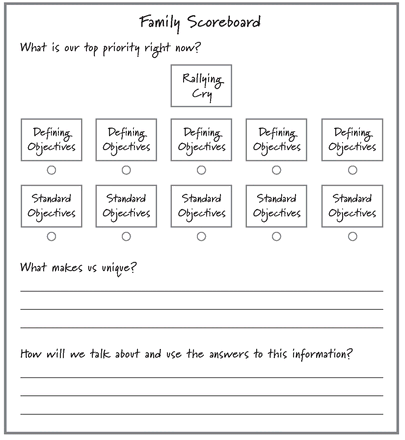QUESTION #3
How do you talk about and use the answers to these questions?
One of the most common mistakes people make when they do strategic planning or personal development plans is that they neatly produce a handsome document and bind it for posterity. It would be better to have your three-year-old write it in crayon on the kitchen wall, because at least then you would have to look at it from time to time. Fortunately, there is a better way to keep your uniqueness and top priority alive, one that doesn’t involve crayons or defacing your kitchen. At least not much.
MEETINGS
The most important thing a family has to do to keep its context alive is discuss it in regular meetings. Yes, meetings.
As distasteful as that may sound, it is critical to talk about your context, and most important, regularly assess your progress against defining and standard objectives. How frequently? Every day is too often. Every month is not often enough. Weekly seems like a good idea because it gives you enough time to make progress during the week without removing a sense of urgency.
The key to making these meetings work is keeping them very, very short. Ten minutes should be enough, or maybe twenty if you’re feeling like digging into your issues and getting something done. Anything longer and you’ll find yourself skipping the meetings and forgetting about the whole process.
Start the meetings by going over the rallying cry, and then assess your progress against each of the defining objectives and standard objectives. Use a simple method for evaluating each area—I recommend assigning a color. Green means you’re doing as well as possible, that you are either at or ahead of schedule. Yellow means you’re doing okay but that there is some concern or risk if you don’t keep pushing forward. Red means you’re way behind and it needs immediate attention. And yes, if you have a hard time deciding between green and yellow, or yellow and red, then by all means, use lime green and orange.
Once you’ve rated your progress on each of the objectives (it should take three to five minutes), discuss those areas that are in need of attention. These will most likely be red or orange, or even yellow. Agree on what needs to be done that week to move those colors in a positive direction. And then, and this is key, end your meeting.
It will be tempting during your first meeting or two to keep talking and to go into great detail around some of the items on your list. I don’t recommend this, because it will only create a memory of lengthy meetings that will make it that much harder for you to say, “Come on, let’s do our Sunday night meeting.” Even if you’re climbing into bed and one of you realizes that you forgot to do the meeting, you can easily take ten additional minutes if you know that’s really how long it will take.
Finally, there is the question of who should attend a family meeting. Of course, this depends on the nature of the family and the age of the children. An argument can be made that it should be the parents alone, because they are truly the leaders of the family. Then there is the argument that the whole family should come, so that they feel a part of planning and ownership for what the family is working toward. I think the answer, as it does so often, falls somewhere in between.
Kids don’t need to be involved in identifying the values and strategy and goals. That truly is the parents’ job as adults and leaders of the family. And clearly, some sensitive or complex family issues sometimes should not be addressed in front of children. All of this requires judgment, knowing when exposure gives kids greater perspective and confidence, and when it makes them feel vulnerable and afraid.
My recommendation would be to have the meetings with just the parents, and then talk to the kids about the meeting for a few minutes the next day. Show them what the family needs to focus on, and where progress is being made. But more important than any suggestion I can make is for me to encourage parents to use judgment and make decisions that will best enable the family to improve, not to adhere to some adage that may or may not apply.
VISIBILITY
Keeping your family plan visible is also critical. That means you need to find the best way to capture the information, and then find the right place in your home to display it.
Though I think it’s important not to be overly prescriptive about how you capture and display your family context, I will make a suggestion here.
I recommend something that is neither overly permanent (carving it into your kitchen table isn’t such a good idea) nor overly temporary (don’t write it in dust on the refrigerator). Instead, get a whiteboard or a chalkboard or a bulletin board and write or type your context information on it, large enough to read from more than a few feet away.
Finally, I strongly suggest hanging your scoreboard near your family calendar so that you can have greater, more holistic context for the daily decisions you make about scheduling and activities. Ultimately, those decisions are what make our lives frantic.
More examples from real-life families can be found on page 204.

